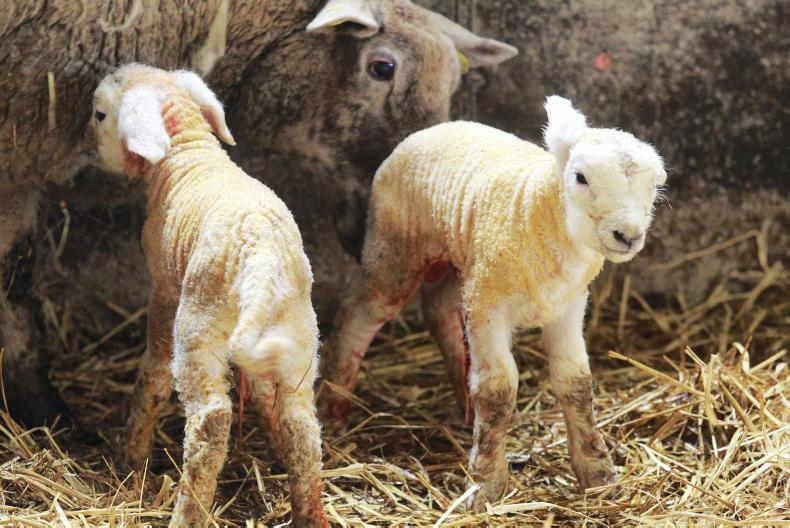Navel/joint ill: There are more reports of joint or navel ill, which is not surprising given the pressure on housing space and challenges in keeping bedding clean and dry. The ailment is a bacterial infection which gains entry via the navel and can spread via the bloodstream to joints, causing bacterial arthritis.
Characteristic symptoms are a swelling in the navel region, with lambs appearing dull and slow to move, suckle etc.
Joint ill can be characterised by swelling in one or more joints in the front or back legs. Cases are generally split 50:50 between one joint and multiple joints.
The four critical aspects in preventing the disease are disinfecting the navel, using products at the correct dilution rate, maintaining a clean environment and ensuring lambs consume sufficient colostrum. Where issues are present it is important to treat navels as soon as possible after birth.
This approach can only do so much, however, as where lambs are being held in a dirty environment, there will be a continued challenge. Some farmers who encounter significant challenges carry out repeat navel treatment after a period of two to four hours.
Adhering to the correct dilution rate helps prevent chemical damage to the soft tissue of the navel, which can increase the risk of infection. Iodine solutions are generally traded at 10% dilution rates.
Some vets favour reducing the dilution rate to 3% to 5%, while chlorhexidine and alcohol-based disinfectants are used with good success on a significant percentage of farms.
The success of treatment for joint ill is highly influenced by early intervention.
Vets can prescribe a course of antibiotics and anti-inflammatory drugs given continually over a period of a few days or alternatively long-acting antibiotics which require repeat treatment at longer intervals.
Advanced cases have a poor prognosis and affected animals which recover can sometimes fail to regain normal performance levels or suffer long-term lameness due to joint injuries. It is also important because navel or joint ill can lead to liver abscesses or peritonitis and longer-term implications for carcase quality.
Lambing records: It is worthwhile keeping a track of issues during lambing so that you are in a position to assess performance at the end of the season. This will identify where changes may need to be made for next year.
Teagasc targets include greater than 90% of lamb numbers identified at scanning being turned out/reared artificially.
Target ewe mortality from mating to the end of lambing is less than 3% while the incidence of prolapse should be 2% or less with a similar target for abortion.
Joint ill and watery mouth targets are a maximum of 1% incidence.
Tail docking: The minimum length of tail that is allowed under legislation is a tail long enough to cover the vulva in female sheep and the anus in male sheep.
A sheep’s tail generally grows in unison with the animal as they get older and therefore a tail long enough to cover the anus and vulva is required at docking.
Tail docking using the rubber ring method should be carried out within seven days of birth. It should be carried out in advance of turnout.
Navel/joint ill: There are more reports of joint or navel ill, which is not surprising given the pressure on housing space and challenges in keeping bedding clean and dry. The ailment is a bacterial infection which gains entry via the navel and can spread via the bloodstream to joints, causing bacterial arthritis.
Characteristic symptoms are a swelling in the navel region, with lambs appearing dull and slow to move, suckle etc.
Joint ill can be characterised by swelling in one or more joints in the front or back legs. Cases are generally split 50:50 between one joint and multiple joints.
The four critical aspects in preventing the disease are disinfecting the navel, using products at the correct dilution rate, maintaining a clean environment and ensuring lambs consume sufficient colostrum. Where issues are present it is important to treat navels as soon as possible after birth.
This approach can only do so much, however, as where lambs are being held in a dirty environment, there will be a continued challenge. Some farmers who encounter significant challenges carry out repeat navel treatment after a period of two to four hours.
Adhering to the correct dilution rate helps prevent chemical damage to the soft tissue of the navel, which can increase the risk of infection. Iodine solutions are generally traded at 10% dilution rates.
Some vets favour reducing the dilution rate to 3% to 5%, while chlorhexidine and alcohol-based disinfectants are used with good success on a significant percentage of farms.
The success of treatment for joint ill is highly influenced by early intervention.
Vets can prescribe a course of antibiotics and anti-inflammatory drugs given continually over a period of a few days or alternatively long-acting antibiotics which require repeat treatment at longer intervals.
Advanced cases have a poor prognosis and affected animals which recover can sometimes fail to regain normal performance levels or suffer long-term lameness due to joint injuries. It is also important because navel or joint ill can lead to liver abscesses or peritonitis and longer-term implications for carcase quality.
Lambing records: It is worthwhile keeping a track of issues during lambing so that you are in a position to assess performance at the end of the season. This will identify where changes may need to be made for next year.
Teagasc targets include greater than 90% of lamb numbers identified at scanning being turned out/reared artificially.
Target ewe mortality from mating to the end of lambing is less than 3% while the incidence of prolapse should be 2% or less with a similar target for abortion.
Joint ill and watery mouth targets are a maximum of 1% incidence.
Tail docking: The minimum length of tail that is allowed under legislation is a tail long enough to cover the vulva in female sheep and the anus in male sheep.
A sheep’s tail generally grows in unison with the animal as they get older and therefore a tail long enough to cover the anus and vulva is required at docking.
Tail docking using the rubber ring method should be carried out within seven days of birth. It should be carried out in advance of turnout.









SHARING OPTIONS